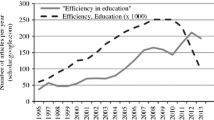Abstract
Nondiscretionary environmental inputs are critical in explaining relative efficiency differences and productivity changes in public sector applications. For example, the literature on education production shows that school districts perform better when student poverty is lower. In this paper, we extend the nonparametric approach to decompose the Malmquist Productivity Index suggested by Färe et al. (American Economic Rewiew 84:66–83, 1994) into efficiency, technological and environmental changes. The approach is applied to analyze educational production of Ohio school districts. Applying the extended approach in an analysis of the educational production of 604 school districts in Ohio, we find changes in environmental harshness are the primary drivers in productivity changes of underperforming school districts, while technical progress drives the performance of top performing school districts.
Similar content being viewed by others
References
Afriat, S. N. (1972). Efficiency estimation of production functions. International Economic Review, 13(3), 568–598.
Althin, R., Färe, R., & Grosskopf, S. (1996). Profitability and productivity changes: an application to Swedish pharmacies. Annals of Operations Research, 66, 219–230.
Banker, R. D., & Morey, R. (1986). Efficiency analysis for exogenously fixed inputs and outputs. Operations Research, 34, 513–521.
Banker, R. D., Charnes, A., & Cooper, W. W. (1984). Some models for estimating technical and scale inefficiencies in data envelopment analysis. Management Science, 30, 1078–1092.
Bradford, D., Malt, R., & Oates, W. (1969). The rising cost of local public services: some evidences and reflections. National Tax Journal, 22, 185–202.
Boles, J. N. (1971). The 1130 Farrell efficiency system-multiple products, multiple factors. Grannini Foundation of Agricultural Economics, University of California, Berkeley
Farrell, M. J., & Fieldhouse, M. (1962). Estimating efficient production functions under increasing returns to scale. J. R Stat. Soc., 125, 252–267.
Cave, D. W., Christensen, L. R., & Diewert, W. E. (1982). The economic theory of index numbers and the measurement of input, output, and productivity. Econometrica, 50, 1393–1414.
Charnes, A., Cooper, W. W., & Rhodes, E. (1978). Measuring the efficiency of decision making units. European Journal of Operational Research, 2, 429–444.
Chen, W.-C., & Johnson, A. L. (2010). The dynamics of performance space of major league baseball pitchers 1871–2006. Annals of Operations Research, 181, 287–302.
Connell, R. W. (1994). Poverty and education. Harvard Educational Review, 64(2), 125–149.
Coleman, J. S. (1966). Equality of educational opportunity. Washington: Government Printing Office.
Estelle, S. M., Jonnson, A. L., & Ruggiero, J. (2010). Three-stage DEA models for incorporating exogeneons inputs. Computers and Operations Research, 37(6), 1087–1090.
Farrell, M. J. (1957). The measurement of productive efficiency. Journal of the Royal Statistical Society, Series A General, 120, 253–281.
Färe, R., & Lovell, C. A. K. (1978). Measuring the technical efficiency of production. Journal Economic Theory, 19(1), 150–162.
Färe, R. S., Grosskopf, S., Lindgren, B., & Roos, P. (1992). Productivity changes in Swedish pharmacies 1980–1989: a non-parametric Malmquist approach. Journal of Productivity Analysis, 3, 85–101.
Färe, R., Grosskopf, S., Norris, M., & Zhang, Z. (1994). Productivity growth technical progress, and efficiency change in industrialized countries. American Economic Review, 84, 66–83.
Färe, R., Grosskopf, S., & Norris, M. (1997). Productivity growth, technical progress, and efficiency change in industrialized countries: reply. American Economic Review, 87(5), 1040–1044.
Førsund, F., & Sarafoglou, N. (2005). The tale of two research communities: the diffusion of research on productive efficiency. International Journal of Production Economics, 98, 17–40.
Grifell-Tatjé, E., & Lovell, C. A. K. (1997). A DEA-based analysis of productivity change and intertemporal managerial performance. Annals of Operations Research, 73, 177–189.
Hanushek, E. (1979). Conceptual and empirical issues in the estimation of education production functions. Journal of Human Resources, 14, 351–388.
Hanushek, E. (1986). The economics of schooling. Journal of Economic Literature, 24, 1141–1177.
Johnson, A. L., & Kuosmanen, T. (2009). How operational conditions and practices affect productive performance? Efficient semi-parametric one-stage estimators, available at SSRN: http://ssrn.com/abstract=1485733.
Kuosmanen, T., & Sipiläinen, T. (2009). Exact decomposition of the Fisher ideal total factor productivity index. Journal of Productivity Analysis, 31(3), 137–150.
Lovell, C. A. K. (2003). The decomposition of Malmquist productivity indexes. Journal of Productivity Analysis, 20, 437–458.
Nishimizu, M., & Page, J. M. (1982). Total factor productivity growth, technological progress and technical efficiency: dimensions of productivity change in Yugoslavia, 1965–78. The Economic Journal, 92, 920–936.
Ouellette, P., & Vierstraete, V. (2010). Malmquist indexes with quasi-fixed inputs: An application to school districts in Québec. Annals of Operations Research, 173(1), 57–76.
Ray, S. C., & Desli, E. (1997). Productivity growth, technical progress, and efficiency change in industrialized countries: comment. American Economic Review, 87, 1033–1039.
Rouse, P., & Swales, R. (2006). Pricing public health care services using DEA: Methodology versus politics. Annals of Operations Research, 145(1), 265–280.
Ruggiero, J. (1996). On the measurement of technical efficiency in the public sector. European Journal of Operational Research, 90, 553–565.
Ruggiero, J. (1998). Non-discretionary inputs in data envelopment analysis. European Journal of Operational Research, 111(3), 461–469.
Ruggiero, J. (2000). Nonparametric estimation of returns to scale in the public sector with an application to the provision of educational services. Journal of the Operational Research Society, 51, 906–912.
Sueyoshi, T., & Aoki, S. (2001). A use of a nonparametric statistic for DEA frontier shift: the Kruskal and Wallis rank test. OMEGA, 29, 1–18.
Thanassoulis, E., & Portela, M. C. A. S. (2002). School outcomes: sharing the responsibility between pupil and school. Education Economics, 10(2), 183.
Tulkens, H., & Vanden Eeckaut, P. (1995). Non-parametric efficiency, progress and regress measures for panel data: methodological aspects. European Journal of Operational Research, 80, 474–499.
U.S. News and World Report. (2009). America’s best high schools: gold medal list, Retrieved November 15, 2010 from http://education.usnews.rankingsandreviews.com/articles/education/high-schools/2009/12/09/americas-best-high-schools-gold-medal-list.html.
Vaz, C. B., Camanho, A. S., & Guimarães, R. C. (2010). The assessment of retailing efficiency using network data envelopment analysis. Annals of Operations Research, 173(1), 5–24.
Author information
Authors and Affiliations
Corresponding author
Rights and permissions
About this article
Cite this article
Johnson, A.L., Ruggiero, J. Nonparametric measurement of productivity and efficiency in education. Ann Oper Res 221, 197–210 (2014). https://doi.org/10.1007/s10479-011-0880-9
Published:
Issue Date:
DOI: https://doi.org/10.1007/s10479-011-0880-9




